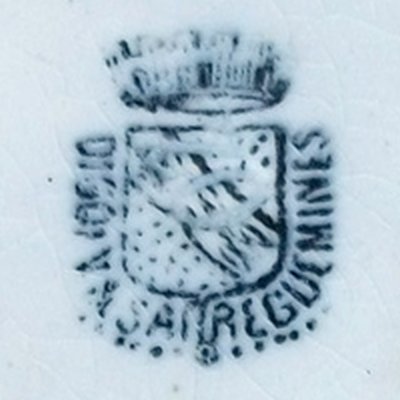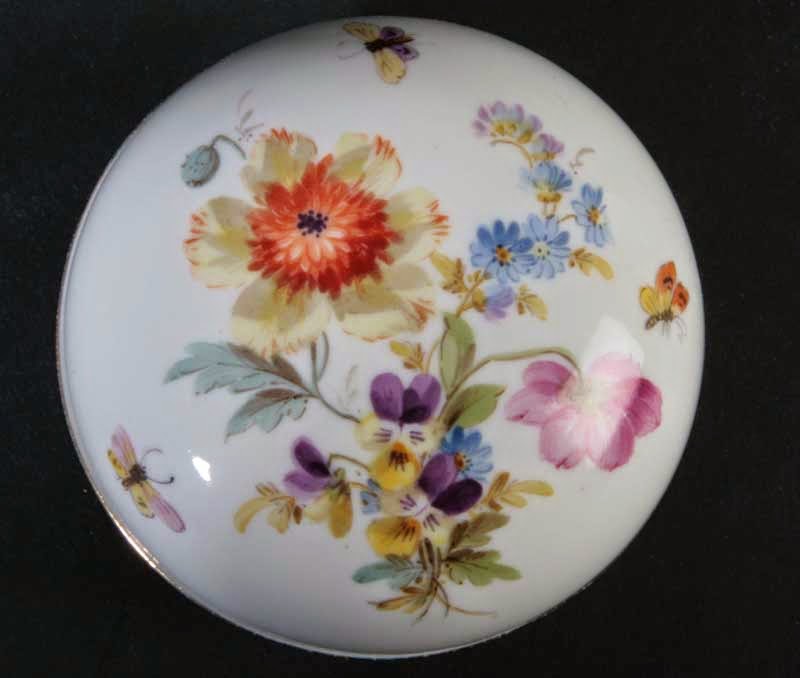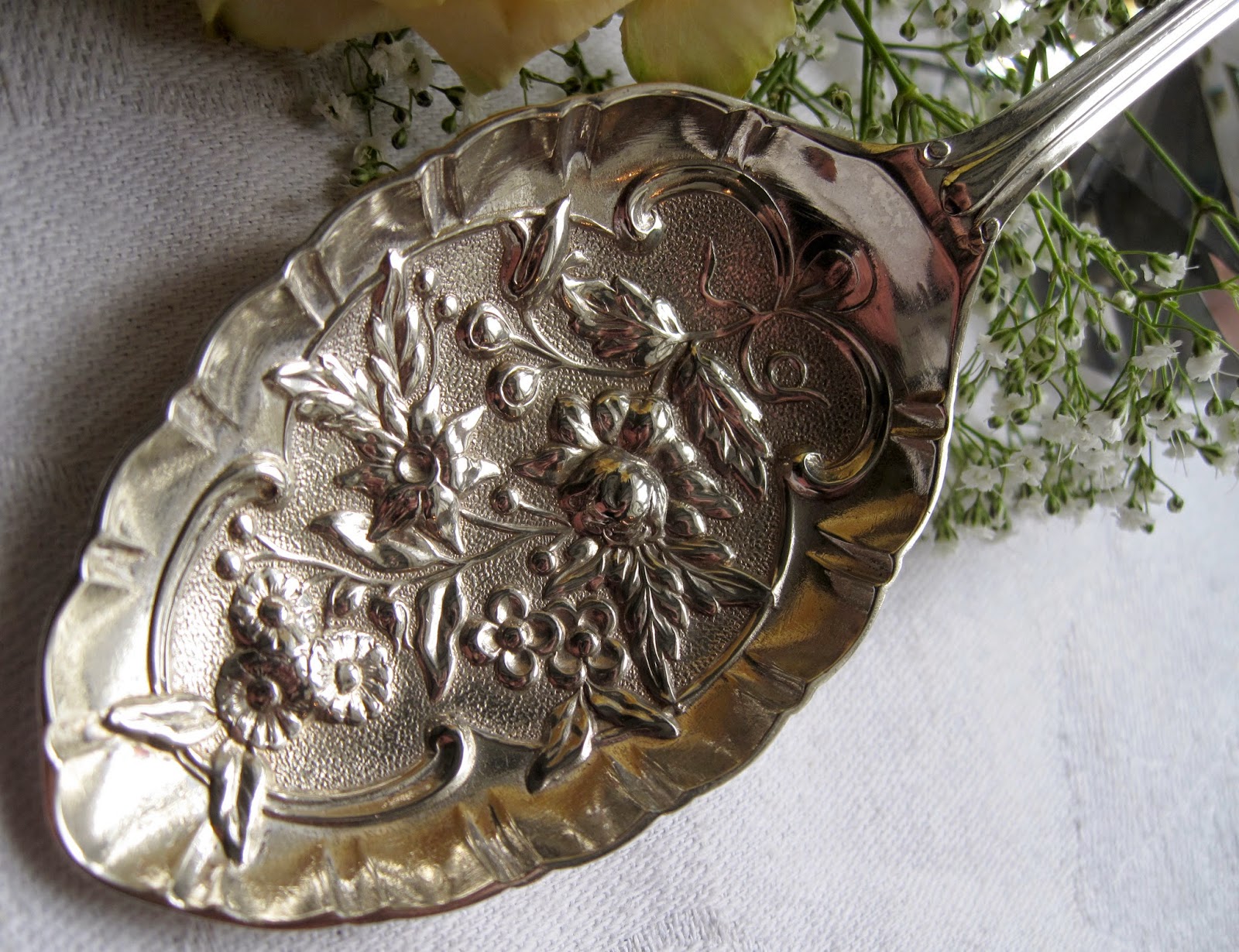Our Topic for March 2015 was:
How Flowers Inspire Us
Flowers have, and will always inspire me, in different ways.
Since I've started my blog I've shown nearly every blossom and flower of our garden,
of some friend's garden, some creations....and...and....
Inside our house I prefer a rather neutral look,
a neutral palette of natural colors, no strong patterns,
no "flowering" pillows, curtains or so, and no large flower bouquets.
In general I simply prefer to see flowers in the nature,
but I like to have a few "flowering accents"
here and there in our house, on the wall,
in the kitchen and
for special occasions on the dining table together with pure white.

I love and admire how painters (Old Master's Still lifes), artists,
have been inspired by flowers, by the nature.
(Meissen, around 1900)
To bring the "garden into our home" I've collected over the years
some "flower" objects, porcelain/ceramic plates ...etc....
(Meissen, early 20th Century)
Faïences,
jugs/pitchers
and...
of course - old linen napkins and table cloths.
*
*
A few of my favourite pieces from my collection
with some background history of the manufacturers
of French Porcelain and ceramic:
French porcelain manufactory Ch. Pillivuyt & Cie, Paris
"Mistletoe"
1818 : Jean Louis Richard Pillivuyt founded a porcelain factory in Foëcy.

Pillivuyt was honored with numerous successive medals
during Universal Expositions/Worlds Fair of 1823,
1853, 1863, 1878
and Grand Prix in both 1867, 1889 and 1900
The Exposition Universelle of 1900 was a world's fair held in Paris, France, from 15 April to 12 November 1900,
to celebrate the achievements of the past century and to accelerate development into the next.
The style that was universally present in the Exposition was Art Nouveau
*
*
German Meissen plates,
decorated with the "Meissner Rose" (Moss Rose)
'Pfeifferzeit' - 1924-1934
Meissen Breakfast board
*
*
Porcelain/Ceramic Breakfast boards
Meissen - Zwiebelmuster "Onion patter"
*
*
2 diner plates - Manufacture de Nast, circa 1800
The manufacture de Nast was a prominent hard-paste porcelain factory
founded in Paris in 1783 by Jean Népomucène Hermann Nast, an Austrian born French citizen.

After working at a porcelain manufacturer in Versailles,
Nast opened his own small factory in Paris in 1783.
Following its successes through sales to the government of the French Directory and the court of Napoleon I the firm needed increased production and Nast with his two sons opened a large factory
located on the rue du Chemin-Vert in the 11th arrondissement of Paris in 1806.
Coffee/Tea pot by Nast, late 18th Century
decorated with "barbe bleue" - cornflowers,
Marie Antoinette's favourite flower design.
*

Nast's products were sold to the French upper class and to several courts of Europe,
as well as one of the earliest state china services,
used by President James Madison in the White House in or about 1814
(purchased privately on Madison's behalf in 1806 when he was Secretary of State,
and used by him as President after the burning of the mansion
and its contents by the British in the War of 1812).
Following the death of Nast in 1817, the factory continued under the leadership of his sons.
Visiting an exhibit of the firm's wares at the Louvre during the Paris Expostition of 1819
(also called the Restoration Exposition), Louis XVIII gave Nast's sons praise -
"I observe with great pleasure the talent passed from father to son, I urge you to cultivate this."
Nast's two sons continued management of the manufacture de Nast until its sale in 1835.
info source: wikipedia
*
*
*
19th Century metal flower arrangements
*
*
*
"Easy care"
in my store room, the barn:
French 19th Century metal leaves with biscuit flowers arrangements....
....which I've "planted" (cemented) in old seedling pots
*
*
*
Blue and White:
Large bowl by
Vieillard et Cie. - David Johnston, Bordeaux, circa 1880
C’est en 1840 que Jules Vieillard, natif de Paris, déjà réputé dans le domaine de la porcelaine,
s’associe avec David Johnston qui dirige dans le quartier de Bacalan une grande manufacture de faïence, occupant plus de 700 ouvriers et produisant 70.000 pièces par semaine.
Bordelais d’origine anglaise, David Johnston qui va devenir maire de Bordeaux,
quelque peu dépassé par la gestion de l’entreprise,
sera contraint de la céder en février 1845 à son associé Jules Vieillard.
*
*
Digoin - Sarreguemines, circa 1880

*
*
French 18th Faïence...
....with late 19th fine hemp
*
*
Meissen Breakfast board
*
*
Porcelain/Ceramic Breakfast boards
*
*
2 diner plates - Manufacture de Nast, circa 1800
The manufacture de Nast was a prominent hard-paste porcelain factory
founded in Paris in 1783 by Jean Népomucène Hermann Nast, an Austrian born French citizen.

After working at a porcelain manufacturer in Versailles,
Nast opened his own small factory in Paris in 1783.
Following its successes through sales to the government of the French Directory and the court of Napoleon I the firm needed increased production and Nast with his two sons opened a large factory
located on the rue du Chemin-Vert in the 11th arrondissement of Paris in 1806.
Coffee/Tea pot by Nast, late 18th Century
decorated with "barbe bleue" - cornflowers,
Marie Antoinette's favourite flower design.
*

Nast's products were sold to the French upper class and to several courts of Europe,
as well as one of the earliest state china services,
used by President James Madison in the White House in or about 1814
(purchased privately on Madison's behalf in 1806 when he was Secretary of State,
and used by him as President after the burning of the mansion
and its contents by the British in the War of 1812).
Following the death of Nast in 1817, the factory continued under the leadership of his sons.
Visiting an exhibit of the firm's wares at the Louvre during the Paris Expostition of 1819
(also called the Restoration Exposition), Louis XVIII gave Nast's sons praise -
"I observe with great pleasure the talent passed from father to son, I urge you to cultivate this."
Nast's two sons continued management of the manufacture de Nast until its sale in 1835.
info source: wikipedia
*
*
*
19th Century metal flower arrangements
*
*
*
"Easy care"
in my store room, the barn:
French 19th Century metal leaves with biscuit flowers arrangements....
....which I've "planted" (cemented) in old seedling pots
*
*
*
Blue and White:
Large bowl by
Vieillard et Cie. - David Johnston, Bordeaux, circa 1880
C’est en 1840 que Jules Vieillard, natif de Paris, déjà réputé dans le domaine de la porcelaine,
s’associe avec David Johnston qui dirige dans le quartier de Bacalan une grande manufacture de faïence, occupant plus de 700 ouvriers et produisant 70.000 pièces par semaine.
Bordelais d’origine anglaise, David Johnston qui va devenir maire de Bordeaux,
quelque peu dépassé par la gestion de l’entreprise,
sera contraint de la céder en février 1845 à son associé Jules Vieillard.
*
*
Digoin - Sarreguemines, circa 1880

*
*
French 18th Faïence...
....with late 19th fine hemp
*
*
*
*
Silver plated Berry spoons:
*
*
*
*
*
*
French antique damask linen with flower designs:
*
*
*
*
*
*
*
*
Silver plated Berry spoons:
*
*

*
*
*
*
French antique damask linen with flower designs:
*
*
*
*
*
*
*
*
*
*
At last but not least....
Flower Power par excellence:
about 90 pieces of a diner service
by Utzschneider Cie., Sarreguemines, 1880-1900
each single piece is decorated
with hand painted different flower arrangement!
Simply unique!
Short history of Sarreguemines and the
manufactory:
1790: Production started in 1790 when
Nicolas-Henri Jacobi,
set up the first factory despite the unfavorable economic climate.
set up the first factory despite the unfavorable economic climate.
*
The dynamic Bavarian Paul Utzschneider took over the factory in 1800
and introduced new decorating techniques.
Napoleon I became one of his best customers and ordered several pieces.
Business quickly increased, and the firm soon had to open new workshops and acquire several mills.
The protests provoked by the consequences of deforestation
induced the company to use coal instead of wood, but it was not until 1830
that the first coal-fired kilns were built.
1836 Utzschneider handed over the
management of the factory to his son-in-law, Alexandre de Geiger.
1838 Alexandre de Geiger associated
himself with Villeroy & Boch.
This agreement contributed to the growth of production.
This agreement contributed to the growth of production.
1871 Following the annexation of the
Moselle to Germany,
Alexandre de Geiger left Sarreguemines and retired in Paris.
His son, Paul de Geiger, took over the management.
Two new factories were constructed at Digoin and Vitry-le-François.
Alexandre de Geiger left Sarreguemines and retired in Paris.
His son, Paul de Geiger, took over the management.
Two new factories were constructed at Digoin and Vitry-le-François.
1913 The Utzschneider & Cie was split
into two companies,
one responsible for the establishment in Sarreguemines and the other for the French factories.
one responsible for the establishment in Sarreguemines and the other for the French factories.
Mark: U & C = Utzschneider and Companie, Sarreguemines,
Decor "Strasbourg"
*
*
*
*
*
*
*
**
*
*
The reputation of the faience of Sarreguemines requires no further
endorsement.
In two centuries time the small family venture, established during the Revolution, has gone a long way.
Admirers of the lively and colourful pieces can be found all over the world.
In two centuries time the small family venture, established during the Revolution, has gone a long way.
Admirers of the lively and colourful pieces can be found all over the world.
Paul Utzschneider and Paul de Geiger, real artists,
have brought the small city to the top of the earthenware industry:
from the 19th century Sarreguemines has provided the whole world with a vast collection of earthenware, vases, decorative flower pots, wall frescos, chimneys, and so on....
have brought the small city to the top of the earthenware industry:
from the 19th century Sarreguemines has provided the whole world with a vast collection of earthenware, vases, decorative flower pots, wall frescos, chimneys, and so on....
*
*
*
I do apologize for being so late with my post,
lots of things happen during these first months of the year,
at La Pouyette, in the world...etc....
and -
had to go to Germany, earlier than foreseen.
I've prepared the post - to some extend - beforehand...then running out with time....
...and so on....
Nevertheless - I thought better late than not at all.
*
Please visit Marsha's blog for all
"flower" posts of our group
lots of things happen during these first months of the year,
at La Pouyette, in the world...etc....
and -
had to go to Germany, earlier than foreseen.
I've prepared the post - to some extend - beforehand...then running out with time....
...and so on....
Nevertheless - I thought better late than not at all.
*
Please visit Marsha's blog for all
"flower" posts of our group
Question from Marsha:
"...do you think it is possible for flowers to make us happy?"
My answer: YES!
Wish you all a very good and flowering week!
A bientôt.....


















































.jpg)



+-+2.jpg)














